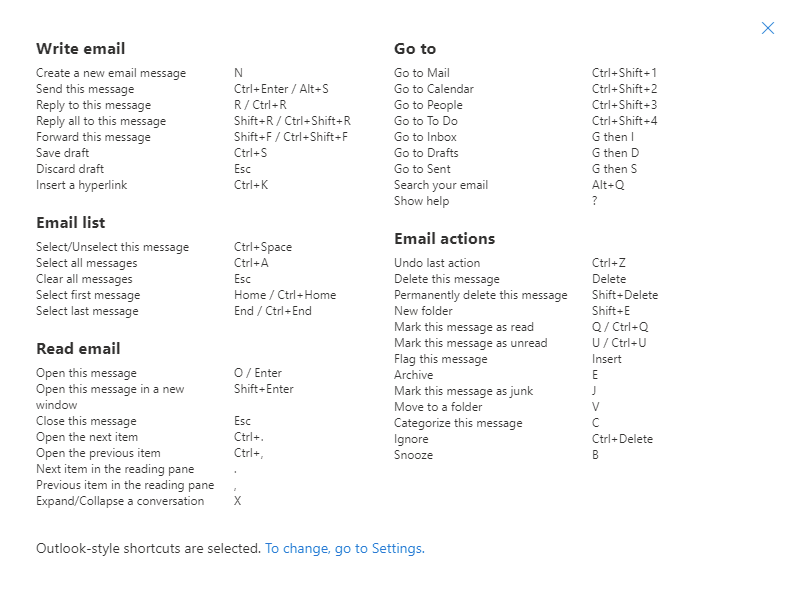
Working with folder and list views: Action With a message open, Move to the Previous or Next message (Navigation pane, Message list, Reading pane, or To-Do Bar) Reverse when reading a message in reading pane using Single key reading.Ĭreate a new item of the current folder typeĬreate a new Appointment (from any Outlook folder)Ĭreate a new Contact (from any Outlook folder)Ĭreate a new Task (from any Outlook folder)Ĭreate a new Message (from any Outlook folder)Ĭreate a new journal entry (Removed from Outlook 2013)Ĭreate a new Contact Group (distribution list)Įxpand dropdown menus, use arrow keys to select from list (Single key reading with space bar can be disabled in Options.) Rotate Navigation pane on, off, minimizedįorward as attachment (Outlook 2007 and up)Īdvance through message in reading pane, then move to next message. When editing items | Appointment and Meeting shortcuts | Calendar shortcuts | Task shortcuts Outlook's main window | Reading messages | Working with folder and list views
OUTLOOK FOR MAC CREATE SHORTCUT ON TOOL BAR WINDOWS
This is a Windows shortcut and works in most programs it will also bring up the Shutdown window, which is handy in Windows 8.

Use Ctrl+Y to open the folder picker.Īlt+F4 will close the current window. Ctrl+4, 5, 7, and 8 ( 9 if you use BCM) cover the rest of the navigation pane modules. Ctrl+Alt+1 through 5 switches from a day (1) to work week (2) to week (3) to month (4) then schedule view (5).Ĭtrl+1 jumps to the Mail module, while Calendar is Ctrl+2, Contacts are Ctrl+3. If you are looking at your day, week or monthly calendar, Alt+0 thru 9 (or, 1 through 0) displays the next 1 to 10 days. Use Ctrl+Alt+S to open the Send & Receive Settings dialog. Want to initiate a send and receive? Use F9 instead of the Send & Receive button. Paste breaks the pattern, but V is more convenient to use after Ctrl+C or X. Those shortcuts are Ctrl+C, Ctrl+X, Ctrl+V and Ctrl+A. It would be nice if we had shortcuts for Junk Email, Drafts and Sent Items…Ĭopy, Cut, Paste and Select All work in most (or all) Windows programs. Need to go to the Inbox? Use Ctrl+Shift+I. Need to Reply to a message? Use Ctrl+R, or Ctrl+Shift+R to Reply All. Alt+S will Save and Close contacts, appointments, and tasks (since they can't be sent.) Use Alt+S to Send an email, meeting or task request. To Save the item you are working on, press Ctrl+S (this is Save in all Windows applications). Notice the pattern? Tasks and Meetings break the pattern as you’ll use Ctrl+Shift+K for a new tas k and Ctrl+Shift+Q for a new meeting, but appointments can be turned into meetings easy enough. Use Ctrl+Shift+M for new Mail when you are working in any folder, Ctrl+Shift+A for new Appointment, Ctrl+Shift+C for new Contact, or Ctrl+Shift+N for Note. If you’re in a mail folder, Ctrl+N will open a new message form if you are in the calendar, you'll get a new appointment form.

Ctrl+N will also open a new message form when you are viewing a Mail folder, but I like the shortcut that works anywhere in Outlook - it's easier to remember when I use it all the time.Ĭtrl+N will get you a New item form in any folder. I don't know about you, but I think the keyboard shortcut of Ctrl+Shift+M would be faster. I started thinking about this when a guy told me creates new messages by opening sent messages and replacing the contents because his new mail button was missing.


 0 kommentar(er)
0 kommentar(er)
